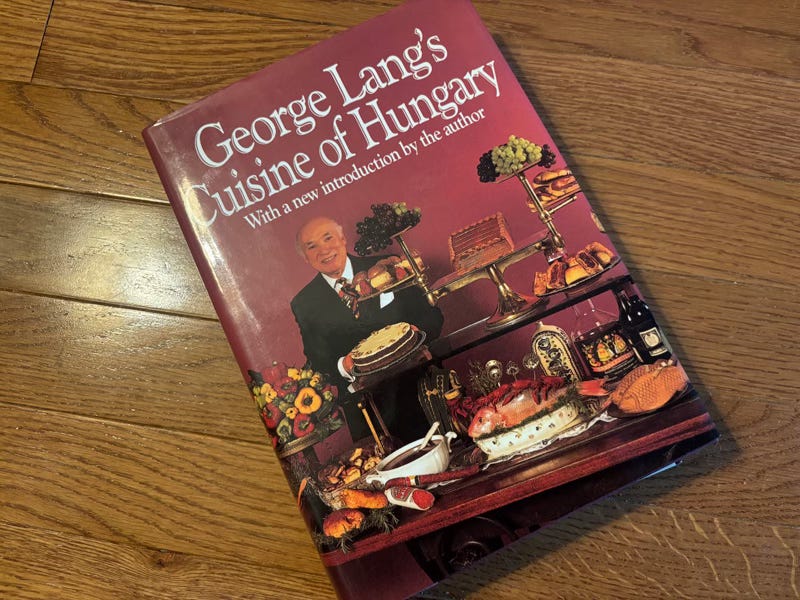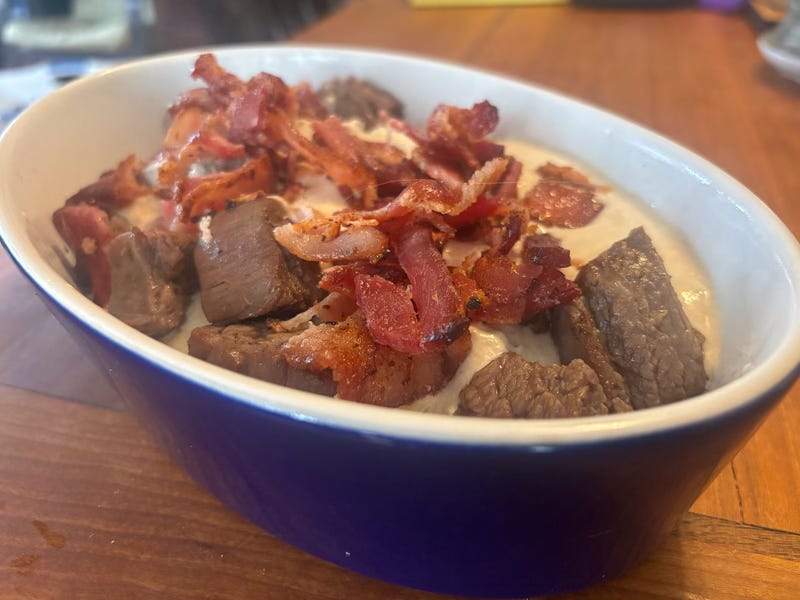THE COOKBOOK TEST #0086: GEORGE LANG'S CUISINE OF HUNGARY
INSTALLMENT #0086 (FREE) TO KILL A LOBSTER / POVERTY FOOD / BEEF IT UP
Dear Readers,
If you're like me, you've never heard of George Lang, the author of today's cookbook, GEORGE LANG'S CUISINE OF HUNGARY. But like many of the authors of the vintage cookbooks that I dig into, he's got a fairly incredible life story. As a young man in Hungary he escaped the Nazis (his family was Jewish and both his parents were killed in Auschwitz) and he hid from further persecution by joining the pro-Nazi Arrow Cross.
Lang then emigrated to the United States, helped create The Four Seasons Restaurant, went on to develop more than 400 culinary projects, bought New York City's Cafe des Artistes, and returned to his native Hungary to buy the world-famous Gundel restaurant in Budapest.
While George Lang's Cuisine of Hungary is well-stocked with recipes (most are profoundly folksy and stick-to-your-ribs in nature), its best quality is that it's a storehouse of its author's storytelling. Here's Lang writing about the legendary hospitality of restaurateur Károly Gundel:
One of his former chefs tells this story. When a guest ordered a lobster and then sent it back, Gundel came to inspect the crustacean. When he sniffed it, he paled - the complaint was justified; the fish was "over the hill." In his restaurant this sort of thing could not happen! The best proof of a lobster's freshness is that it is still alive when it is dropped into the court-bouillon. This lobster surely wasn't!
Immediately he went to the kitchen to fire the fish butcher. With tears in his eyes, the latter insisted that the lobster was alive when he started to cook it. Gundel, instead of losing his head, began to think of all the possibilities, and narrowed it down - like a sharp detective - to a chance that the lobster had been fed with a piece of spoiled meat. After rechecking, they found that this was exactly the case, and as a result, the fish butcher could stay. The guest, of course, was not allowed to pay the bill and was re-invited to dinner.
What elements do I like about this story?
A) A legitimately knowledgable customer with a legitimate complaint
B) A savvy restaurateur checking up on that complaint before acting
C) Serious consequences for serving bad food (firing the fish butcher)
D) Serious consideration for a cook's livelihood (checking the fish butcher's story)
E) Real hospitality - the bill comped, the customer invited to dine again
It is, in short, a little capsule summary of a restaurant that's working properly. Guests taken care of, employees taken care of, systems checked and improved to deliver healthy and delicious food. As an anecdote, it's a little thing of beauty.
at your service,
James
GEORGE LANG'S CUISINE OF HUNGARY
BY GEORGE LANG
WINGS BOOKS | 1994
If the first unusual thing about George Lang's involvement in this book is the sheer scale of his restaurant enterprises at the time of its publication, the second must surely be the way Lang - a rich man - writes about poverty and food. He dedicates several pages in his book to the poverty food of Hungary, writing about using fried onion to replicate the flavors and texture of pork or fish, about how to make passable meat stock without meat, and about his own experiences in the Second World War:
Poverty, of course, is a very relative term, and entire provinces in Hungary probably would object to the notion that eating potatoes without meat is a sign of poverty. The people of the Nyirség (and some other counties) had to catch, cook, and live on sparrows, crows, and gophers. They had to grind tree barks into a kind of flour and bake bread with it, and on very special "red letter days" make a "chestnut" puree out of mashed beans to celebrate an important event. Not only did they have to rub chicory beans against coffee beans, dropping the chicory beans into the water to make coffee, but at times even the substitute became scarce and they had to rub the chicory beans against some kind of wild plant and use the latter to make coffee. (During World War II, I tried everything to quiet my demanding stomach, but I did not find a pancake made of dried corncob flour very satisfactory.)
This is a legitimately bizarre thing to read in a cookbook, and it is in some ways a very welcome one. As relatively prosperous Americans, we have been so insulated against hunger that we have lost touch with how terrible it can be, and the fact that in truly trying times hunger can affect and ravage nearly anyone, anywhere.
I think I can remember being truly hungry exactly once in a life, when I was caught in a rainstorm while on a days-long hike and unable to reach supplies. For a 24 hour period, I was hiking long distances over rough terrain in the rain without more than a couple handfuls of gorp to eat, and when my group was finally able to find a road to civilization and reach a diner, we all ordered a full breakfast of eggs, bacon, toast, and pancakes. We ate that breakfast, and then ordered a second full breakfast, and then ate that too. As a one off, it was a novelty that I recall with fondness and amusement - I can't imagine how crazy-making it would be go to through food deprivation on a regular basis.
At any rate, George Lang's Cuisine of Hungary has plenty of provisions for good, fattening times (the sample menus include the wonderfully named A Repast on Pig-Killing Day and An Elegant Dinner Anno 1900), but also plenty of simple, hearty, humble meals that can be made inexpensively. It's a pretty cool artifact of a different place and time.
BEEF IT UP
I made this book's Lemon Beef because I've never really eaten a beef dish premised on its lemon-boosted qualities before and because it looked to be tremendously hearty and satisfying. It was both of those things, for sure - the stacking up of tender beef, lots of crushed bacon, and a lemon/tarragon/sour cream dressing made for a marvelously flavorful and rich dish.
My amended recipe below changes exactly one thing: It calls for the preparation of egg noodles (ala stroganoff) to serve as a bed for all the beefy sour cream bacon goodness. For as much as I enjoyed this meal, I would have enjoyed it even more with something mellow and neutral to help moderate its meaty power.
LEMON BEEF
2 pounds lean beef chuck, cut into 1-inch cubes
1 cup beef broth
4 slices of bacon
1 Tbsp bacon drippings
1 Tbsp flour
Egg noodles to serve four people
1 cup sour cream
1 1/2 Tbsp lemon juice
1 tsp fine-grated lemon rind
1/2 tsp sugar
1 Tbsp chopped tarragon
Cook cubed beef in beef broth in covered Dutch oven until tender. Remove meat from pot and cool broth.
In a frying pan, fry bacon until crisp. Remove bacon and crumble but leave drippings in the pan.
Add beef to hot drippings and cook, covered, for 5 minutes.
Prepare egg noodles.
In separate pan, make a roux with 1 Tbsp bacon drippings and flour. Stir constantly and cook until golden brown. Whip the cooled broth into the roux and then whip in sour cream, lemon juice, lemon rind, sugar, tarragon.
Pour the lemon sauce on the meat, and place in a serving casserole. Sprinkle it with crisp bacon. Serve on egg noodles.
GEORGE LANG'S CUISINE OF HUNGARY
(BUY IT / ***BORROW IT*** / SKIP IT / SCRAP IT)
Unless you happen to be from Hungary, of Hungarian descent, or particularly interested in Hungary, George Lang's Cuisine of Hungary would be a bit of a stretch - its recipes are tremendously specific and mostly of one vein (rustic and filling.) But the book's introduction is so lengthy and beautifully written, and so rich with specific detail, that it could serve as a model for how to root a cookbook in a particular place, from a particular writer's vantage point.



